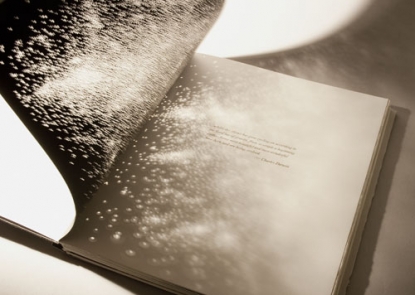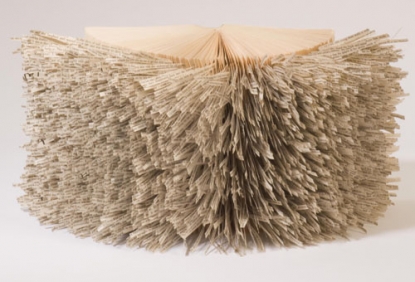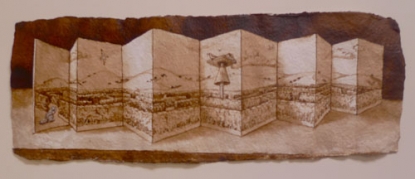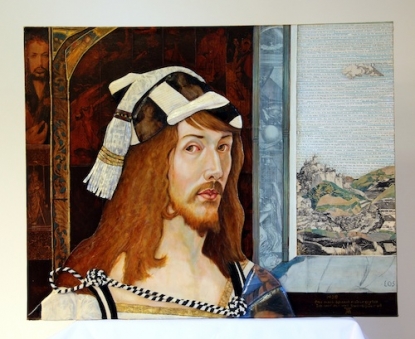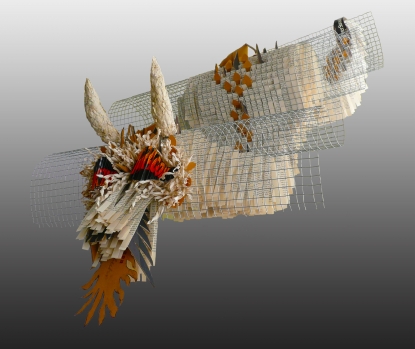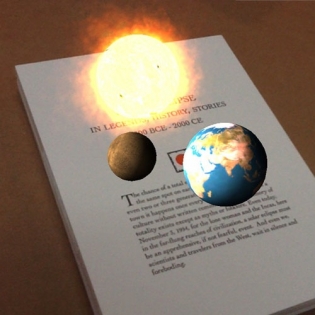
Totality: A Digital Over Analog Book (2012), Penny Nii, Mohammed Allababidi, Enrique Godivia, Paper book and smart phone/tablet (Apple or Android operating system)
Feature: Reviews
Altered Books
Sheds built from used lumber, quilts made from worn clothing—the reuse of existing objects is a time-honored tradition. So is impromptu adaptation—the matchbook used to shore up the short leg of a café table. Repurposing of materials for practical reasons is a common human activity, one practiced daily by engineers and composers, carpenters and surgeons.
Doing so for something as frivolous as art has a much shorter history. The use of manufactured commodities as art became commonplace in the mid-20th century, the result of a single incident—Marcel Duchamp’s submission of a porcelain urinal as a piece of sculpture for an exhibit in 1917.
His jest outraged academics and traditionalists alike—Fountain was not shown in the exhibit—but it had a profound effect on the thinking of generations of artists who followed. Duchamp’s conceptual breakthrough—that anything can be taken out of context and viewed anew as art—was the Big Bang of contemporary art, the moment that made possible everything from Andy Warhol’s Brillo boxes to Jeff Koons’s household appliances in vitrines to Tracey Emin’s tryst-stained bed and Damien Hirst’s dead critters in formaldehyde.
Altered books are informed by both traditions. Adapting objects for something other than their intended purpose imparts meaning—and sometimes, wonder—that the original makers might never have imagined.
Running concurrently through the month of May are two Marin county exhibits that explore the realm of altered books.
The first is “The Art of the Book,” at Seager-Gray Gallery in Mill Valley. Gallery partners Donna Seager and Suzanne Gray McSweeney have put together an amazing show at their new space at 23 Sunnyside, featuring books reconfigured as sculpture, disassembled and re-used as design elements, or carefully hand-constructed in the time-honored letterpress tradition. At least one, Totality: A Digital Over Analog Book, by Penny Nii and Mohammed Allbabidi, brings the ancient art of bookmaking into the 21st century with embedded symbology that when scanned with an iPad brings up images related to the text.
The pieces on display at Seager-Gray vary from intensely personal—Dodger Blues by Nikki Thompson humorously conflates her love of baseball with personal gender issues—to purely abstract, as in Masked Words by Doug Beube and Luna by Daniel Essig, both carefully-constructed evocations of science fiction creatures that are light years from “Star Wars” parodies.
Some are serious books whose production took an extraordinary amount of love and attention, such as the handmade The Island of Rota, with text by psychiatrist/neuroscientist Oliver Sachs, images by photographer Abelardo Morell, and design by Ted Meuhling. This “tactile volume,” as Seager calls it, examines an island where the entire human population is colorblind. An homage to illustrated natural history books of the late 19th and early 20th centuries, it’s a work of exquisite beauty.
Other pieces, such as painter Claudia Marseille’s encaustic Finding True North, evoke antiquity without specificity. Lisa Kokin’s Fauxliage: Obligation to Endure and Overcast explore paradoxes and multiple meanings in word exercises of daunting delicacy. Some works are astounding for the sheer obsession and tenacity required to bring them to life: Samantha Y. Huang’s Read Between the Lines, the book equivalent of a shaggy dog, made by carefully extracting every other printed line from a paperback; and two carefully dissected pieces by Brian Dettmer, A Loose Leaf and Still Revising Reference Work, made of antique encyclopedias, and Egyptian Book of the Dead, riffing on the catacombs of the Pyramids.
The other exhibit on the bookish theme is “The Altered Book Show” at Marin Museum of Contemporary Art. Organized by artist Eleanor Murray and juried by Seager, the show features works by 150 artists. A substantial number of the works at MarinMOCA are of the caliber of their Seager-Gray counterparts—such as First Prize winner Linda Mueller’s The World of Durer, or Leslie Allen’s delicate Stereo Nudes: A Positive-Negative Reflection, her stunning reinterpretation of the stereopticon of old, the first imaging technology offering a semblance of 3D.
Many artists at MOCA play with perspective: Eric Engstrom offers a West Marin landscape in Arrow Between Olema and Tocaloma, while Ellen Golla tackles the developmental arc from ape to scientist in Man. Then there is the alternate world worked up by Lorna Stevens, whose untitled piece turns an old Encyclopedia Britannica atlas into a globe with oceans and land masses, none identifiable.
The prolific Bonnie Kuhr has three wonderful pieces in the MOCA show, including a nod to Chinese New Year, Floating Dragon, made from the novel of the same title, and two pieces based on a library of miniature Shakespeare plays. Whimsy is rampant at MOCA, too, such as Noel Ryan’s Alice in Wonderland and Through the Looking Glass; Kirk Hinshaw’s Between the Lines; and For the Love of Shoes, by Susan Press. Perhaps tops in the whimsy department is Text Styles by Christine Stewart—two hats made from books, but as far from paper hats as you can imagine.
Marin MOCA’s April 21 opening event drew approximately 300 people to the gallery at the old Hamilton air base headquarters. A fundraiser for the museum, the month-long exhibit culminates in an auction and closing party on Saturday, May 26 from 5 to 7 p.m.
“The Art of the Book” at Seager-Gray Gallery, 23 Sunnyside Ave., Mill Valley runs through May 31. Hours: 11 a.m. – 6 p.m. Tuesday-Saturday; 12 to 5 Sunday. 415-384-8288 www.seagergray.com
“The Altered Book Show and Auction” at Marin Museum of Contemporary Art, Novato Arts Center at Hamilton Field, 500 Palm Drive, Novato, runs through May 26, 11 a.m. to 4 p.m. Wednesday-Sunday. 415-506-0137 www.marinmoca.org

